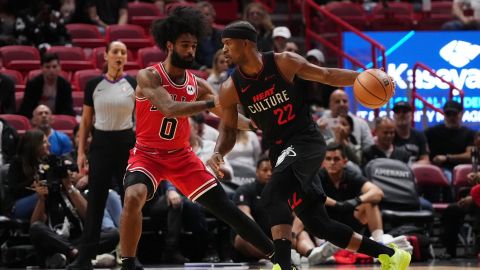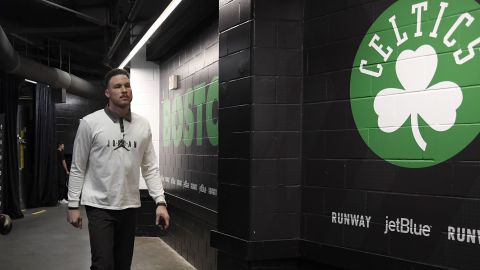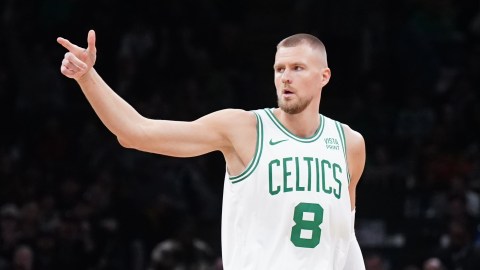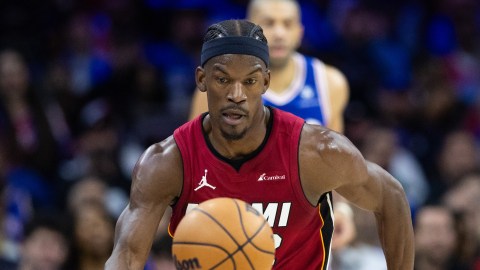 Three-pointers are worth more points than two-pointers. Write down that little piece of trivia, use it at parties to attract the opposite gender or mail it into the admissions office at Harvard to show that you’re ready for them to give you that Ph.D. you’ve always wanted.
Three-pointers are worth more points than two-pointers. Write down that little piece of trivia, use it at parties to attract the opposite gender or mail it into the admissions office at Harvard to show that you’re ready for them to give you that Ph.D. you’ve always wanted.
Now that we’re all Mensa material, let’s get back to the main point. The patently obvious fact that threes are worth more than twos can be critical to success in the NBA. For all the clichés about establishing a low-post presence and crashing the glass, two of the more reliable predictors of a team’s success are how well it shoots threes and how well it defends them.
This is relevant for the Celtics because, coming off a 101-89 loss to the Houston Rockets on Friday, defending the three officially has become a problem for them. Much of the Celtics’ success over the last five years was built on not only shooting well from long-range but also limiting opponents’ effectiveness from beyond the arc. Teams can live and die by the three. So far, the Celtics have done both — depending on the shooting prowess of their opponents.
Celtics coach Doc Rivers was livid at his guards for allowing so much dribble penetration Friday, leading to 40 points in the paint for the Rockets. That would seem to suggest that Boston’s problem was down low and not on the perimeter, but both shortcomings are actually two sides of the same coin.
As Rivers pointed out, defensive breakdowns in the backcourt force the frontcourt players to adjust. Close observers of the Celtics over the years know that Rivers’ defenses depend greatly on the post players’ ability to give help on the strong side and the weak-side defenders’ ability to essentially play a miniature zone to cover multiple offensive players. The system has brought Boston a championship and three trips to the Eastern Conference Finals, but it is not as airtight this season as it has been in past years.
The 3-point defense is symptomatic of this larger issue. When the perimeter defenders cannot stop the ball, the post defenders need to leave their assignments. The guard or wing player covering the weak side — who already has to contend with at least two offensive players — has to compensate for the big guys in the paint. The result is wide-open 3-pointers for those weak-side players, or easy swing passes to another open shooter as the Celtics’ defenders scramble to recover.
Their struggles are evident in the statistics. The Celtics entered Friday allowing opponents to shoot 35 percent on threes, making them the 13th-best defense in the NBA. That might not seem very bad until one considers that the Celtics were the best in the business at defending the arc last season at just 30.8 percent, and they were never worse than fifth against the three in the “Big Three” era.
Holding teams to a low percentage has been only part of Boston’s success, however. They have also been one of the league’s stingiest teams in allowing those deep looks over the last three years. Fewer shots at a lower percentage mean fewer made baskets. (That’s another pro tip you can feel free to put in your Harvard application.) When opponents start to shoot more — and this year they have, partly because 3-point shooting is up across the league — while shooting a higher percentage, one can imagine how quickly the defense breaks down.
That was why the thing about Friday’s game that should truly worry the Celtics was not the damage the Rockets were able to inflict in the paint or even that Houston shot 37 percent from downtown. No, the really troubling statistic was the 27 attempts the Rockets took from beyond the arc. If the Rockets could do that, then the Knicks and Heat — who also shoot a lot of threes but with far more accuracy than Houston does — are pretty much unguardable for the Celtics.
The Celtics, of course, fancy themselves as those teams’ peers. But if the Knicks can counter every Kevin Garnett jumper with a Steve Novak triple, and if the Heat can respond to every Rajon Rondo runner with a Ray Allen trey, the Celtics stand no chance.
You know, because three points are more than two.
Have a question for Ben Watanabe? Send it to him via Twitter at @BenjeeBallgame or send it here.



